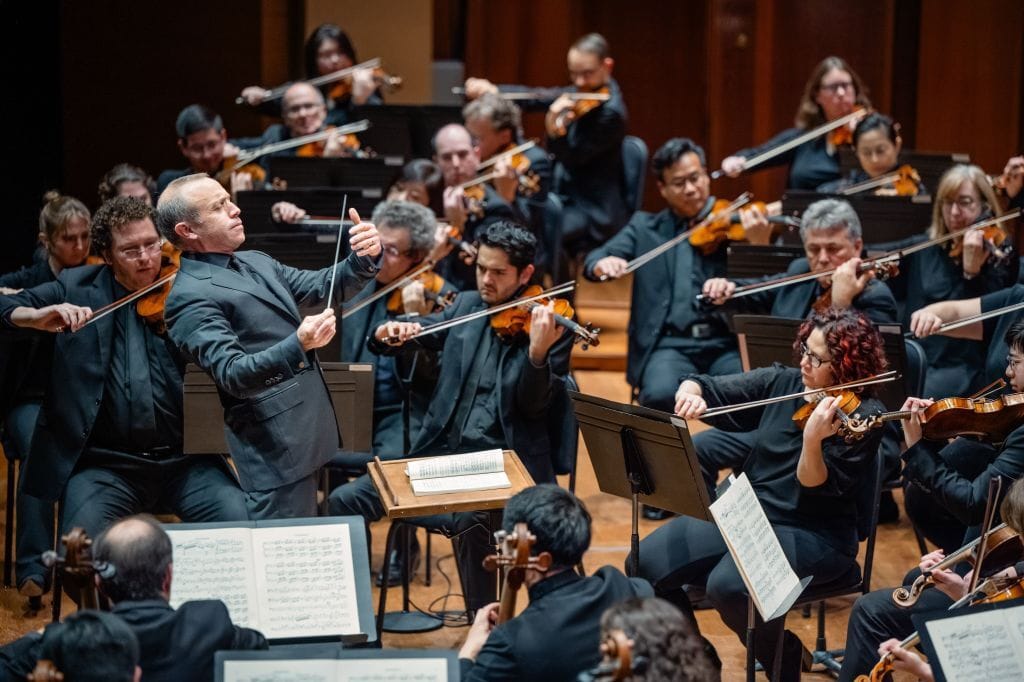- Gathering Note
- Posts
- Seattle Symphony shines in Brahms and Elgar, courtesy of Wigglesworth and Hough
Seattle Symphony shines in Brahms and Elgar, courtesy of Wigglesworth and Hough

Mark Wigglesworth and the Seattle Symphony, Photo Credit Brandon Patoc
Also published at Seen and Heard International
After an arguably slow start to its 2023-24 season, the Seattle Symphony is gearing up for a packed schedule of concerts in November and December highlighting works by Brahms, Beethoven, Sibelius, Elgar, and Mahler. For the first concert of this ramp-up, the orchestra deftly tackled two major works with guest conductor Mark Wigglesworth’s first turn at the podium: Brahms’ Second Piano Concerto — featuring soloist Stephen Hough — and Elgar’s Second Symphony..
Hough has frequently performed in Benaroya Hall over the years, often playing crowd-pleasing works by Rachmaninov. This time, he traded in Rachmaninov for Brahms, taking on challenging work composed during a productive time in Brahms’ life, which also yielded his Second Symphony and Violin Concerto. Brahms’ First Piano Concerto dazzles with youthful bravura. But in contrast, the composer fills his Second Concerto with a varied and lyrical journey: The first two movements feature bracing moments, the somber third movement includes longing paragraphs of music and affecting cello and horn solos. And if that wasn’t enough, the piece concludes with a playful, catchy closing movement.
Hough masterfully navigated through the concerto’s diverse moods. His performance was marked by dynamism, demonstrating an unforgiving intensity in grappling with the grand themes, yet unveiling overwhelming tenderness in the third movement with a sensitive touch that seemed superhuman. In the finale, Hough propelled the music forward with nimble fingerwork that exuded a contagious sense of joy.
Wigglesworth proved to be both a commanding and supportive conductor for the concerto. It was an impressive debut with the symphony. Wigglesworth skillfully allowed the orchestra to unleash its full potential when the music called for it, yet he adeptly maintained a delicate balance between orchestra and soloist at other moments. And best of all, the orchestra sounded muscular — supported by sturdy playing from the low strings and brass.
After intermission, WIgglesworth returned with another meaty work: Elgar’s Second Symphony unfolds as a gradual, contemplative journey. Its beauty flows uninterrupted by the existential drama typically associated with large symphonic compositions. The symphony’s muted radiance conceals an otherwise idiomatic late-Romantic soundworld. While traces of Mahler’s influence can be discerned in the orchestration, Elgar’s primary intention to honor King Edward VII lends the work a more intimate quality than anything Mahler could have envisioned. Wigglesworth conducted a dynamic performance marked by heartfelt expression, meticulous phrasing, and discerning tempo choices.
Seldom are there performances where a guest soloist and a guest conductor are so expertly matched. Hough and Wigglesworth recorded the Brahms concertos for Hyperion, which demonstrated the possibilities of their musical partnership. Fortunately Seattle audiences were able to hear the partnership firsthand. Wigglesworth also seemed to have established a strong partnership with the orchestra, resulting in a memorable performance of Elgar’s elusive masterpiece.